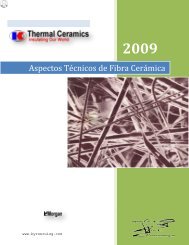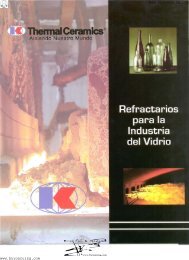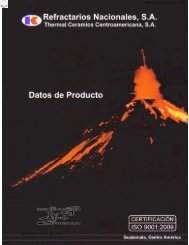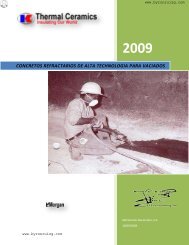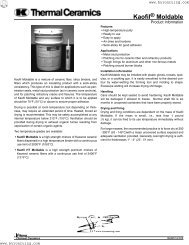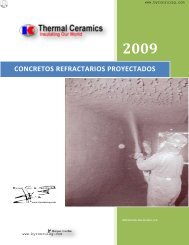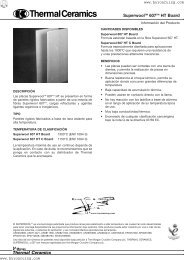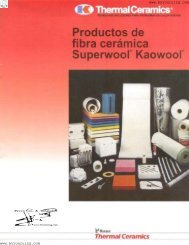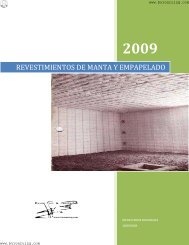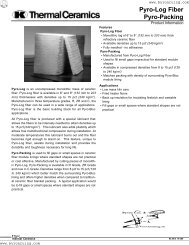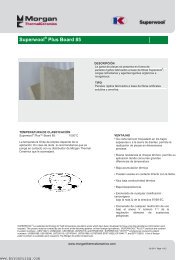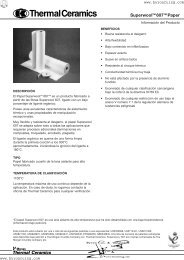Untitled
Untitled
Untitled
Create successful ePaper yourself
Turn your PDF publications into a flip-book with our unique Google optimized e-Paper software.
www.byronruizg.com<br />
www.byronruizg.com<br />
What were the test results?<br />
Elements SW607HT RCF 1260 Competitor<br />
AES 1260°C<br />
Legend:<br />
Reaction starts from<br />
this temperature<br />
SW Plus<br />
Mo/MoO 3 800°C (1472°F) 800°C (1472°F) 800°C (1472°F) 800°C (1472°F)<br />
Ni/NiO<br />
SnO 2<br />
Zn/ZnO<br />
Mn/MnO<br />
Cr<br />
Sn<br />
Fe<br />
1150°C (2102°F)<br />
1100°C (2012°F)<br />
1000°C (1832°F)<br />
Cu/CuO 1100°C (2012°F) 1100°C (2012°F) 1150°C (2102°F) 1000°C (1832°F)<br />
B 2 O 3 Start before 700°C 1100°C (2012°F) 800°C (1472°F) 700°C (1292°F)<br />
K 2 CO 3 900°C (1652°F) 900°C (1652°F) 900°C (1652°F) 900°C (1652°F)<br />
Na 2 CO 3 800°C (1472°F) 900°C (1652°F) 800°C (1472°F) 800°C (1472°F)<br />
Pb/PbO 800°C (1472°F) 800°C (1472°F) 800°C (1472°F) 800°C (1472°F)<br />
P 2 O 5<br />
Start before 700°C<br />
(1292°F)<br />
700°C (1292°F)<br />
Start before 700°C<br />
(1292°F)<br />
Start before 700°C<br />
(1292°F)<br />
V 2 O 5 1100°C (2012°F) 1150°C (2102°F) 900°C (1652°F) 900°C (1652°F)<br />
Bi 2 O 3 1100°C (2012°F) 1150°C (2102°F) 900°C (1652°F) 900°C (1652°F)<br />
Conclusions / recommendations<br />
• All fibre chemistries demonstrate varying degrees of reactivity with a majority of elements.<br />
In Superwool ® 607 HT and Superwool ® Plus applications, the following elements<br />
indicate a risk to product performance:<br />
Mo/MoO 3<br />
Alkali (such as K 2 CO 3 /K 2 O, Na 2 CO 3 /Na 2 O, B 2 O 3 )<br />
Pb/PbO<br />
P 2 O 5<br />
V 2 O 5<br />
Bi 2 O 3<br />
Calcium<br />
Silicate<br />
Cu/CuO<br />
Zn/ZnO<br />
Alumino<br />
Silicate<br />
Magnesium<br />
Silicate<br />
• A combination of contaminants will worsen the chemical attack<br />
•<br />
•<br />
Calcium/<br />
Magnesium<br />
Silicate<br />
No reaction observed along its typical range<br />
of use (Continuous use temperature)<br />
Elements reacting at<br />
very low temperature<br />
and should be avoided<br />
From experience it is known that both sulphur and HF will produce a strong attack<br />
If an application does not contain these elements or are working at a lower temperature<br />
than the reaction starting temperature, Superwool ® 607 HT ® and Superwool ® Plus<br />
will perform well in the application. Where contamination is anticipated which may cause<br />
a reaction with the fibre lining, it is recommended to discuss the best practical solution<br />
to lining design with your local Morgan Thermal Ceramics office.<br />
Contamination / Pollution Study<br />
61



